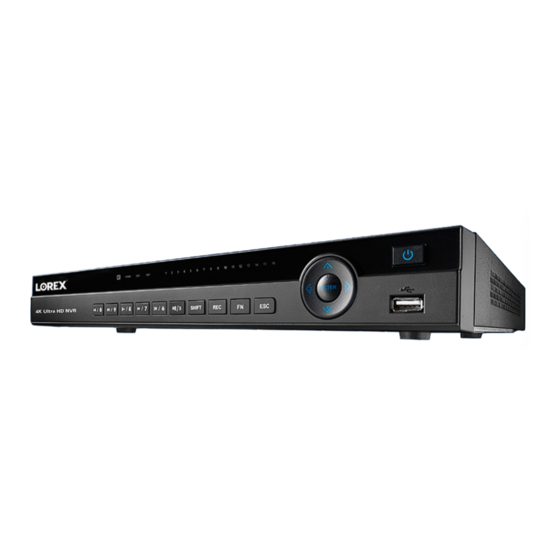
Advertisement
Quick Links
1 / 2
Quick Setup Guide
Physical setup of recorder and essential system settings
NR900X Series
Package Contents
4K Network Video Surveillance Recorder
Remote Control
Power Adapter
Dimensions
14.7" / 375mm
Need Help?
Visit us online for up-to-date software
and complete instruction manuals
1
Visit lorex.com
Search for the model
2
number of your product
Click on your product
3
in the search results
4
Click on the Downloads tab
Copyright © 2019 Lorex Corporation
As our products are subject to continuous improvement, Lorex reserves the right to modify product design,
specifications and prices, without notice and without incurring any obligation. E&OE. All rights reserved.
Ethernet Cable
USB Mouse
12.9" / 327mm
2.1"
53mm
Setting Up Your Recorder
Follow the steps below to complete physical setup of your recorder.
To set up your recorder:
STEP 5:
Connect power
8-channel configuration shown. 16/32 channel will have the respective number of video inputs.
Back panels shown below are for illustration only. Your recorder's back panel
may appear different, with all the same ports in different locations.
STEP 1:
Connect IP cameras*
Connect your IP cameras (not included) using one of the following methods:
a. Connect cameras directly to the recorder (recommended).
b. Connect cameras to a PoE switch or router on your network (not included). See "Adding
Cameras from the LAN" on reverse for more details.
NOTES:
•
This guide covers connecting IP cameras to your security recorder only. For full instructions
on installing your cameras, please refer to your camera's documentation at lorex.com.
HDMI Cable
•
Connecting cameras to a router, or a network switch without PoE, requires a power adapter
for each camera. Refer to your camera's documentation at
adapter model number.
STEP 2:
Connect router*
Connect the recorder to your router using the included Ethernet cable.
NOTES:
•
If you are using a PoE switch, ensure the switch is connected to the same network as your
recorder.
•
To receive automatic firmware updates and enable remote viewing with computer and
mobile apps, a high speed Internet connection is required (minimum 3.5Mbps upload
speed). All other system features can be used without an Internet connection.
STEP 3:
Connect monitor*
Connect the recorder to a monitor using the included HDMI cable or a VGA cable
(not included). The HDMI port supports up to 4K resolution, and VGA supports up to
1080p.
NOTE:
To optimize picture quality, set the recorder's video output to match the resolution of
your monitor.
STEP 4:
Connect mouse
Connect the included mouse to a USB port on the recorder.
STEP 5:
Connect power
Use the included power adapter to connect the recorder to a nearby outlet. Turn the
recorder on using the power switch on the back panel.
Overview of extra ports:
NOTE:
For full instructions on using the extra ports, please refer to your security recorder's
instruction manual at lorex.com.
STEP 1:
STEP 2:
Connect IP cameras*
Connect router*
For camera compatibility information, visit lorex.com/compatibility.
OR
Audio I/O
Connect microphone / speaker*
RS232
Connect access control systems*
STEP 3:
Connect monitor*
STEP 4:
Connect mouse
* Not included / sold separately.
OR
lorex.com
for the correct power
Alarm Block
Connect alarm devices*
NR900X_QSG_EN_R1
Advertisement

Summary of Contents for Lorex NR900X Series
- Page 1 Copyright © 2019 Lorex Corporation As our products are subject to continuous improvement, Lorex reserves the right to modify product design, specifications and prices, without notice and without incurring any obligation. E&OE. All rights reserved. NR900X_QSG_EN_R1...
- Page 2 NOTE: Please visit lorex.com/compatibility for a list of compatible Lorex IP cameras. playback. To add cameras from the LAN: b. Check channels you want 1. Connect the camera to a router or switch on the same network as the recorder.











